#Royal Navy Commandos
Text

Opération Chariot : le HMS Campbeltown encastré dans la porte de la forme Joubert du port et de la cale sèche de Saint-Nazaire et sabordé par les marins britanniques - Bataille de l’Atlantique - Saint-Nazaire - France - 28 mars 1942
Photo : Kramer
©Bundesarchiv - 101II-MW-3722-03
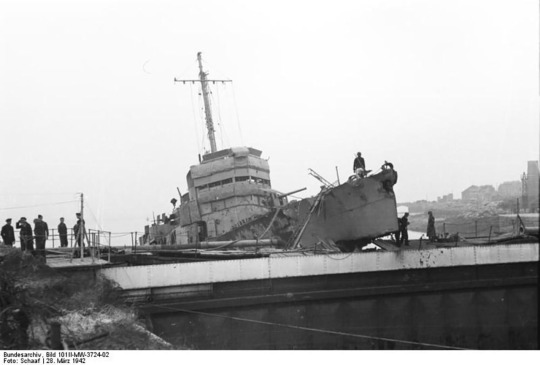
Opération Chariot : le HMS Campbeltown encastré dans la porte de la forme Joubert du port de Saint-Nazaire avant son explosion - Bataille de l’Atlantique - 28 mars 1942
Photo : Schaaf
©Bundesarchiv - 101II-MW-3724-02
Dès 1939, la domination militaire de l'Atlantique est un enjeu stratégique déterminant du conflit mondial. Après la défaite de la France, la Grande-Bretagne est tributaire des convois de ravitaillement pour soutenir son économie et son effort de guerre. Quant à l'Allemagne elle impose un blocus maritime pour vaincre son dernier adversaire en Europe. Une stratégie d’attaque en meutes de sous-marins est alors mise en place par l’Amiral Dönitz complété par le déploiement de navires de surfaces lourdement armés et cuirassés.
Pour sa première sortie opérationnelle, le cuirassé Bismarck, a pour mission de déstabiliser la route des convois transatlantiques et coulera le croiseur de bataille HMS Hood, fleuron de la Royal Navy. La marine britannique a dû déployer d’énormes ressources navales et des efforts considérables pour venir à bout du Bismarck avant qu’il ne rejoigne le port de Brest pour réparations.
Dans ce contexte, le sister-ship du Bismarck, le cuirassé Tirpitz, plus grand cuirassée d’Europe à flot stationné en Norvège devient une menace incontournable pour la marine britannique et la sécurité des convois de ravitaillement.
La doctrine maritime de l'époque exigeant la présence d'un port pour effectuer les réparations à proximité des navires qui s’engagent en opération, le seul port de la façade atlantique capable de recevoir le cuirassé est celui de Saint-Nazaire avec sa forme Joubert (Porte-écluse pour accéder au port et cale sèche).
Cet ouvrage a une telle importance stratégique que Winston Churchill décide, au début de l’année 1942, d’en confier la neutralisation aux commandos britanniques sur la base de renseignements fournis par le réseau de résistance « La Confrérie Notre-Dame », commandé par le Colonel Rémy.
Le plan consiste à utiliser un navire-bélier bourré d’explosifs, le destroyer HMS Campbeltdown maquillé en destroyer allemand, contre les portes de l'écluse-caisson et de neutraliser 24 cibles techniques par des commandos à terre. Pour cela une opération de bombardement aérien a pour objectif de distraire les défenses allemandes tandis que le destroyer, 16 vedettes rapides, 1 vedette lance-torpilles et 1 canonnière foncent sur leurs objectifs profitant de l’effet de surprise.
Le destroyer encastré dans la porte de la forme Joubert à 1 h 34 du matin explose quelques heures plus tard à 10 h 30 avec à son bord de nombreux soldats allemands venus l’inspecter.
L’opération fut un succès et la forme Joubert resta inutilisable jusqu’à la fin de la guerre.
#WWII#bataille de l'atlantique#battle of atlantic#opérations commando#commando operations#opération chariot#operation chariot#raid de saint nazaire#st nazaire raid#marine britannique#royal navy#destroyer#hms campbeltown#saint-nazaire#st nazaire#france#28/03/1942#03/1942#1942
9 notes
·
View notes
Text
youtube
#youtube#militarytraining#Military Cooperation#Tactical Operations#Amphibious Operations#Special Forces#Naval Operations#Amphibious Warfare#Navy SEALs#Combat Drills#Joint Exercises#Military Alliances#Royal Marines#Military Training#Army Rangers#Special Ops#Warfare Tactics#Marine Corps#Military Exercises#International Forces#Elite Forces#Commando Training
1 note
·
View note
Text

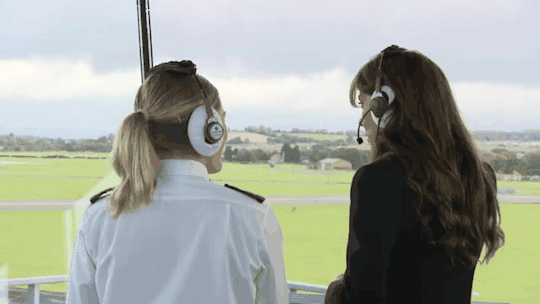
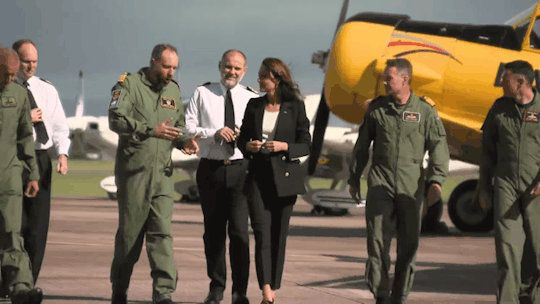
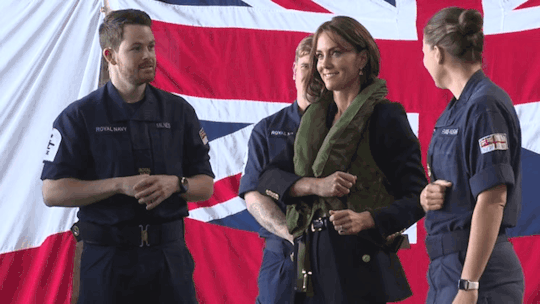






THE PRINCESS DIARIES ♚
18 SEPTEMBER 2023 || ROYAL NAVAL AIR STATION YEOVILTON
The Princess of Wales paid a visit to Royal Naval Air Station Yeovilton in her role as the Commodore-in-Chief of the Fleet Air Arm.
During her visit Catherine met and conducted training exercises with the Royal Navy Survival Equipment (SE) Technicians. She also met service personnel and viewed - the Merlin MK4 and the Merlin MK2.
The former is deployed by Royal Marine Commandos globally to provide disaster relief. While the latter is an Anti-Submarine Warfare platform used for a variety of activities including tracking submarines, supporting disaster relief operations and providing training for the next generation of engineers and aircrew.
Catherine also spent time in the Air Traffic Control (ATC) tower where she visited the Visual Control Position to meet with staff and view the aircraft operating in the airfield. She also visited a hangar to engage with personnel and hear about different operations within the Fleet Air Arm.
The Princess of Wales also visited the Wildcat Training Centre, to meet the loading team who are trained to fit a variety of weapons to the Wildcat MK2 helicopter.
This was Catherine's first engagement in her new role.
#princess of wales diaries#princess of wales diaries 23#princess of wales#the princess of wales#princess catherine#catherine wales.#my gifs#royaltyedit#royalty gifs#royalty edit#18092023#british royal family#british royals#royalty#royals#brf#kate middleton#royal#catherine middleton#duchess of cambridge#british royalty#gifs#RNASYeovilton23
81 notes
·
View notes
Text
So apparently, reading about the Royal Marine Commandos, Philippine Scout Rangers, Navy Seals and other military special forces is one of my guilty pleasures lately...
Which made me wonder : since the Auror training lasts for three years and has a very stringent selection process, I wonder how intense the training is, actually? Do they also have to battle the elements or do some intense resistance training? How does magic complicate the process?
Damn, I wish we could have asked Sharp what it's like to be an Auror...
10 notes
·
View notes
Text
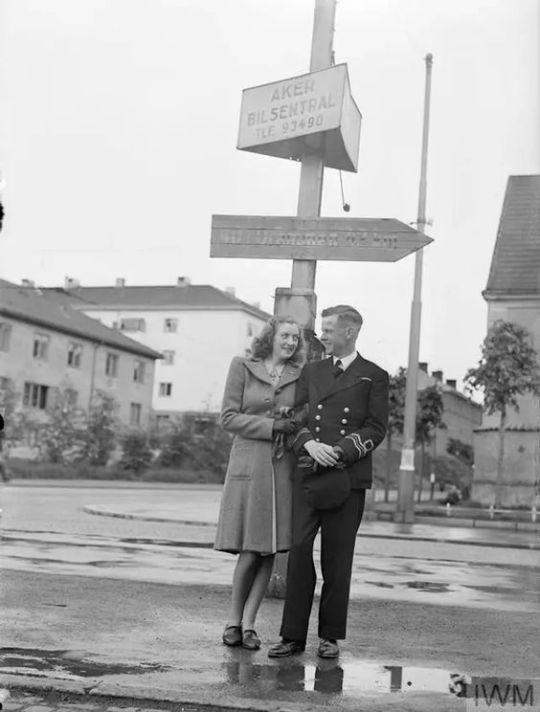
The maverick heroics of MI6 agent James Bond may actually be based on the true story of one brave soldier, who took on the Germans and won again and again. In this archive piece, we look back on Patrick Dalzel-Job's stranger-than-fiction life
If the dashing hero of Ian Fleming's best-selling spy thrillers were among us, is it likely he could be found living alone on a far-away hill by the sea in Scotland?
A mildly spoken gentleman who lived to his eighties, then grey and a little stooped—could he have been secret agent 007? Come on.
Ah, but life is stranger than fiction.
Some of those who know best have always believed that Fleming based his superspy on a wartime comrade named Patrick Dalzel-Job—yes, our elderly gentleman who lived his final days in the Highlands.
There were other influences, of course. Bond's love of vodka martinis and handmade cigarettes came, in fact, from Ian Fleming himself; and whereas 007 tumbled into bed with a different beauty every few pages, Patrick Dalzel-Job (pronounced Deal-Jobe), loved only one woman all his life.
But there is something here. Consider:
Job, like Bond, was half Scots, a one-time naval officer, a master of languages who in real life performed precisely the kinds of derring-do Fleming later attributed to his flamboyant make-believe hero.
By the time Dalzel-Job walked into Commander Ian Fleming's Admiralty office one day in 1944 looking for a new assignment, he had already seen service as a seaman, commando, submariner and spy, and had just become probably the first naval officer to qualify for army parachute wings.
Fleming, an ex-journalist who had broadcast his intention of becoming a best-selling author some day, was then building up the clandestine army of naval intelligence officers and Royal Marine commandos which was to move out in front of the assault troops on D-Day and capture secret enemy documents and weapons.
He saw in Patrick's flinty blue eyes the look of a man whose mettle has been tested, and promptly signed him on.
Says veteran BBC broadcaster Charles Wheeler, who served with both: "Who could be surprised if a kind of James Bond seed were planted then and there?"
An unconventional childhood
Patrick Dalzel-Job, born in Twickenham, Middlesex, in 1913, was three years old when his father, an infantry officer, was killed in France. His mother, a small, spirited woman, brought him up alone.
They lived on the Sussex coast, then moved to Berkhamsted in Hertfordshire, where Patrick went to school. But he was a sickly boy, inept at team sports and home with mysterious bouts of fever more often than he was in class.
When he was 14, his mother took him to Switzerland, where the mountain air restored his health and he became an expert skier. He continued to read widely in French and English, but his formal education was over.
Drawn to Norway by stories he'd read as a boy, in 1937—the summer of his twenty-fourth birthday—he set sail from Scotland in a 37-foot schooner, Mary Fortune, whose deck work and interior he had built himself.
With his mother as crew, he spent the next two years exploring a wilderness of fiords and islands from Bergen in the south-west to Nordkapp, on the northernmost coast of Europe.
His mother knew nothing of seamanship, but an ingenious array of ropes, chains and pulleys enabled Patrick to man the rugged little schooner single-handed.
Soon he was speaking Norwegian like a native and making friends up and down the western coast. A deep-rooted love for Norway and its people became a cornerstone of his life.
Falling in love with Norway
Wherever he sailed through the complex of waterways, he drew detailed charts, convinced they would be of use to the Royal Navy if war came. But when he sent them to the Admiralty, they were accepted with indifference.
And three years later, when the Germans invaded Norway and coastal charts of any kind were desperately needed, his could not be found.
Meanwhile Patrick, preparing the Mary Fortune for a voyage north to the Arctic Ocean, decided he needed another hand on board and turned to friends in Tromso, the Bangsunds: might one of their children be interested?
The keenest was 13-year-old Bjørg, with her wide blue eyes and a laugh that was the most beautiful sound Patrick had ever heard.
All through that spring and summer, Bjørg was a valiant and valuable shipmate, cheerfully helping out in the galley and learning how to handle the tiller. Then, in early September, their radio brought news that the war had come.
Mary Fortune headed back to Tromso, where all the Bangsunds came to see off Patrick and his mother, their possessions reduced to what they could carry in two suitcases, on the coastal steamer.
As the ship ploughed through the night towards Britain, Patrick found a scrap of paper from Bjørg under his pillow. "I love you," it said.
The nazis and the Norwegians
In April 1940 Patrick, now an officer in the Royal Navy, was again bound for his beloved Norway.
The Nazis, in a brutal move to assure command of the northern sea lanes, had invaded their neutral neighbour, and an Allied expeditionary force was steaming north in an attempt to dislodge them.
Patrick was assigned the task of disembarking the troops at Harstad, 150 miles north of the Arctic Circle, and conveying them to combat staging areas.
This he did by organising fisherman friends, and their friends, into a flotilla of more than 100 of their boats. The objective was nearby Narvik, an ice-free port seized by the Germans as a base from which to protect their supply of vital iron ore from neutral Sweden.
The Norwegians did as Patrick said because they trusted him and he spoke their language; also because he never hesitated to fire a round from his father's old service revolver across their bows when they forgot this was war and not just another fishing trip.
Wearing an unmarked greatcoat over his sub-lieutenant's insignia and barking orders as if born to command, he even had senior officers calling him "Sir".
The Allies captured Narvik—but held it only briefly. They were too few and had come too late. By the end of May, all but a small force had been withdrawn. No one doubted that Luftwaffe bombers would soon be rumbling across the sky, aiming to drive off the rest.
A daring rescue
On May 29 Patrick, standing offshore of the town with his ragtag fishing fleet, learned to his horror that no provision had been made to evacuate the townspeople.
His urgent enquiries only prompted a stern message from force headquarters: he was to hold his boats in reserve and not—"repeat not"—concern himself with the civilian population.
At midnight, a crisis meeting of the city council was still agonising about how they could evacuate the people to the designated safe areas. The then mayor, Theodor Broch, tells what happened next:
"There was a commotion by the door. A young Englishman said he had to talk to me, that we had to evacuate the town. I barked at him that we had no boats."
"I have the boats," said Patrick. "Let's go."
His providential appearance in defiance of strict orders; that clipped self-assurance; rescuing the population of a doomed city—what could have been more James Bondian?
Within the hour, under Patrick's close supervision, women and children were being handed down into the boats.
"I have never forgotten him," says Gerd Carlsson, who was 21 and boarding with her sister and baby nephew. "There was shooting from land and sea, and lines of waiting people, and such a babble of shouting. But he shook each person's hand warmly and was so calm that although I didn't even know where I was going, I wasn't afraid."
During the next two days and nights, 4,500 people were ferried to safety in dozens of communities along the surrounding waterways.
Early on June 2, Patrick and Mayor Broch walked together through Narvik's empty streets, making sure no one was left behind. By then, even the last of the troops had slipped away.
But hours later, while Patrick was still there, the bombers came, turning the town's neat wooden buildings into an inferno, reducing most of them to splinters and ashes.
Patrick watched as Narvik burned, heartsick because he knew there was nothing in the town of military value, only people's homes.
Wartime intelligence
On June 8, Patrick went back to Britain, disillusioned by the Allied defeat, bitter that he hadn't managed to stay behind and organise a Norwegian resistance—and dreading a message from the Admiralty that he was to be court-martialled for gross disobedience of orders at Narvik.
Instead, the Admiralty signalled him with a message from King Haakon VII of Norway: His Majesty would be in London shortly and he would personally present Lieutenant Dalzel-Job with the Knight's Cross of St Olav, Norway's highest order, for saving the people of Narvik.
After that, nothing was heard about a court-martial. But Patrick was relegated to a series of converted merchantmen that zigzagged across the South Atlantic intercepting blockade-breakers or convoying Allied freighters safely to port.
"All this", he recalled in the book he later wrote (and published) about his adventures, "seemed terribly monotonous to me."
Just as he began thinking the war had passed him by, Lord Louis Mountbatten summoned him to London and put him in charge of motor torpedo boat (MTB) operations in Norway. It was particularly dangerous work, for the Germans were throwing all they had into defending Norway's coast.
But Patrick knew plenty of narrow entrance channels that the Germans didn't. His MTBs raised havoc with commando raids, sabotage and attacks on enemy ships.
It forced the Germans to step up defensive operations and induced trepidation quite out of proportion to the number of MTBs employed against them.
Still only a lieutenant, Patrick was next posted to a detachment of midget submarines. In September 1943, he briefed their four-man crews on the remote Arctic estuary where the German battleship Tirpitz was moored in apparent safety; three of the tiny craft crept into the fiord and crippled her in a raid that earned VCs for two of the participants.
Next, equipped with a radio transmitter, he was put ashore on a Norwegian island, on a one-man intelligence mission to track supply convoy patterns through the inland waters.
He knew that capture meant summary execution, on Hitler's own orders. Yet he remembers those three weeks, alone and utterly dependent on his own wit for survival, as among the most exhilarating of his life.
Taken off the island by pre-arrangement, he assuaged his reluctance to leave by directing the MTB that picked him up to a German merchantman whose anchorage he had noted. Two torpedoes finished her off.
James Bond rises through the ranks
On June 10, D-Day-plus-4, Patrick landed on Utah beach in Normandy as a member of Commander Ian Fleming's intelligence hit squad, the 30th Assault Unit (30 AU)—a name intended to mislead, since it was never meant to assault anything and probably took its number from an office door in the Admiralty.
Patrick, promoted to lieutenant-commander, was in command of Team 4, reporting by courier directly to Fleming.
All the way through Normandy, Belgium and into Germany, Team 4 operated ahead of the assault troops in enemy-held territory, getting their hands on German documents, weapons and installations before they could be destroyed by the Germans or by Allied artillery.
Patrick revelled in it; this kind of war, where he was free to set the level of risk, was the kind he wanted to fight. And he sent back a steady stream of data and captured equipment.
He found the control centre for the long-range bombing of Allied convoys in the Atlantic; he recovered intact a new and dangerously effective midget submarine; reaching Cologne 24 hours before any other Allied troops, Team 4 walked unhindered into the vast Schmidding metalworks and took it over.
Patrick's audacity was sometimes breathtaking. When some nuns showed him a heavy safe used by the Germans, he promptly blew it open, breaking every window in the convent. He gave the money in the safe to the nuns for repairs and sent the documents in it to London.
His reports from the field to the desk-bound Ian Fleming kept fleshing out a portrait of the kind of man the would-be writer was conjuring up for his fictional hero. But Patrick's most stunning exploit was still to come.
An impossible stunt
The target was the vast Deschimag shipyard in Bremen where, he had heard from prisoners, there could be as many as 20 of the newest high-speed German submarines—a prize of enormous intelligence value.
But winning it would be a race: the 52nd Lowland Division, following on close behind 30 AU, was planning on blasting the shipyard into oblivion.
In the afternoon of April 26, 1945, Team 4 entered Bremen's deserted central square. A fretful policeman appeared. Please, he said to Patrick in the lead Jeep, would the commander accompany him to the city hall where the mayor was waiting?
Patrick found the mayor, dressed in formal black, alone in the empty, echoing chamber.
"He wanted me to accept the surrender of the city of Bremen and all its services," Patrick recalled, "and he gave me assurances of vigorous police action against any who failed to co-operate fully."
Patrick went at once to radio Army Command that organised military resistance was ended and whatever the Allies wanted would be done. "I told them that, except for some sniping, the city was secure. They didn't have to shell the shipyard."
But the Army did not see it that way. They were going to open fire that very evening, they replied, as soon as they came within range.
Furious, Patrick climbed into his scout car and set out alone for the shipyard, staking his life that there really was no resistance there, and that his presence would keep the Army from shelling it.
Then, at the very gates of the shipyard, his scout car sputtered and died—it had run out of petrol. And when he tried to radio for help, all he got was static; contact had been cut by interference from surrounding buildings.
It's like a bad film, Patrick remembers thinking. But what would happen in the last reel?
He considered going ahead on foot, but needed the rest of his team with the radio truck. Without it, how could he tell the Army he was inside the shipyard? He would only get killed there.
Spotting some workers, he grabbed a bicycle from one of them. Frantically he pedalled back through the sunset to his unit—aware that there was still enough daylight for a sniper to put a bullet in his back.
When he rounded the last corner, his anxiously waiting men hauled him on board the lead vehicle, bicycle and all, and the column sped off for the shipyard at breakneck speed.
Inside, they found 16 brand new submarines and two destroyers, and forestalled their imminent demolition by the shipyard technicians and directors.
Patrick and his men took them all prisoner, and in a night-long search found technical papers detailing the most recent German naval research, as well as machine tools of highly advanced design.
They had not heard the last from the Army. Early next morning, when submarine experts had already begun a detailed study of the captured U-boats, all of the new high-speed Type 21, a British Army staff officer appeared and asked Patrick to sign a receipt for them—implying that the 52nd Division had captured them.
This was the last straw for Patrick. He slammed the gate and had a sign posted on it to the effect that the entire shipyard was the property of 30 AU: "Keep Out!"
Bond gets the girl
The war ended soon after. Patrick never saw Ian Fleming again, nor did the British government reward his wartime valour with even a single honour or citation.
Among those who still wonder why is Rear Admiral Jan Aylen, then a Commander in 30 AU, who calls Patrick "one of the most enterprising, plucky and resourceful people that the Second World War produced".
The reason is not complicated. Frequently Patrick committed the unforgivable offence of disagreeing with senior officers and, worse, being proved right.
Just like James Bond.
As soon as the fighting ended, Patrick responded to the great hunger in his heart and returned to Norway.
Six years had passed; Bjørg was 19 now, a different person. He was different. But as soon as they saw each other, they knew they had only been marking time. They married three weeks later.
The James Bond years, about to begin for Ian Fleming, were over for Patrick. He and Bjørg went to Canada, where Patrick served in the Canadian navy and their son lain grew up.
In 1960 they settled near Plockton in the West Highlands, prepared to continue living happily ever after. Patrick taught in the village school and Bjørg became a pillar of the community until her death, in 1986, of cancer.
Patrick, brave as ever, soldiered on alone. He finally passed away in 2003.
Daily inspiration. Discover more photos at Just for Books…?
11 notes
·
View notes
Text

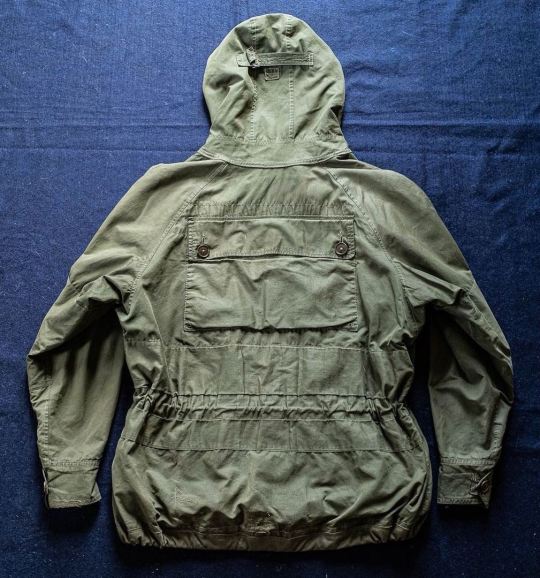


1960’s British SBS (Special Boat Squadron) Ventile “Canoeist Smock”.
These highly unusual Ventile smocks were made for a very short period of time during the 1960’s in seemingly near nonexistent numbers for a very small and specialized British Special Forces unit. The Special Boat Service is an incredibly elite and highly secretive unit within the British Royal Navy that has an unbelievable history of service throughout WW2 all the way up until present day where they are largely responsible for maritime counter-terrorism. They are essentially the UK’s answer to the US Navy SEALs and are mostly made up of Royal Navy Commandos. The smock is about a niche as they come, being made specifically for Canoe/ Kayak operations. It features a number of very unique pockets including the huge back pocket which could be accessed by the person sitting behind the wearer, the huge iconic angled map pocket on the chest, as well as a tiny pocket on the hood itself, possibly for a compass. All pockets feature small eyelets at the bottom for water drainage. Like many of the fine British Military Ventile smocks of the 50’s/ 60’s this example was made by Belstaff as can be determined by the almost unreadably faded BMC stamp shown in slide 4, next to the Broad Arrow.
44 notes
·
View notes
Text
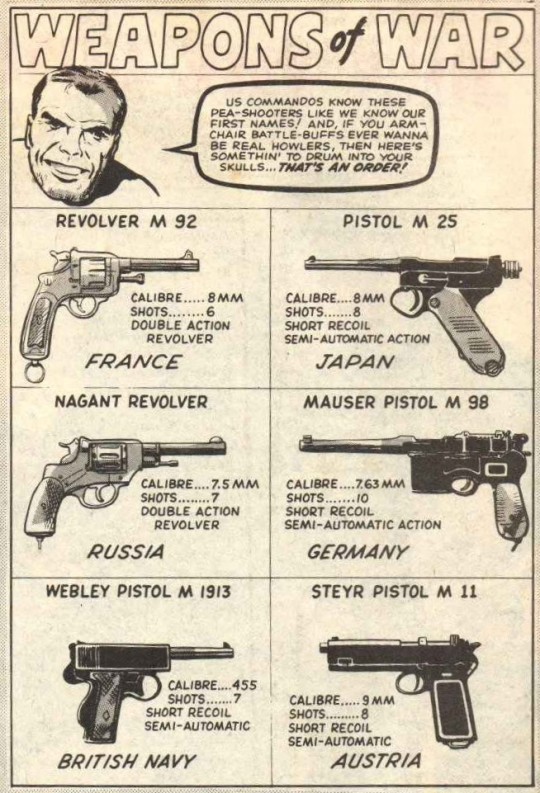
Weapons of War from Fury No. 17, 6 July 1977 (originally from an issue of Sgt. Fury and his Howling Commandos). Some interesting pistols here, a few of which are more First World War era than Second World War.
The Webley Self-Loading Pistol (SLP), shown at bottom left, was originally used by the Metropolitan Police in 1911 before being adopted by the Royal Navy the following year. It was the first semi-automatic pistol in British military service. The article below, from Britain at War No. 182, shows one had sold at auction in 2022 for £900.
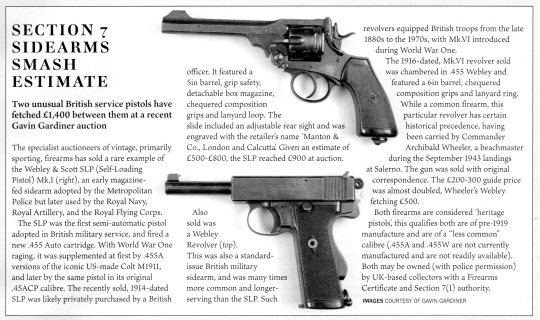
#06jul#fury#webley#1977#marvel#marvel uk#weapons of war#nambu#mauser#britain at war#webley & scott#slp#auction
61 notes
·
View notes
Text
His Majesty The King is announced as Captain General Royal Marines on the 358th Anniversary of the Corps

His Majesty The King will serve as the ceremonial head of the Royal Marines, taking on the role of Captain General. The announcement comes on the 358th anniversary of the founding of the Corps of Royal Marines, which were formed on 28th October 1664 during the reign of King Charles II.
Widely acknowledged as one of the world’s elite fighting forces, the Royal Marine Commandos are the amphibious troops of the Royal Navy. They are deployed across the globe as specialists in combat in extreme climates, serving on the most dangerous operations under the most challenging conditions.
The appointment of the ceremonial head of the Royal Marines has historically been held by the Monarch, including The King’s grandfather and great-grandfather.
In a personal message to the Royal Marines as they mark their 358th birthday today, The King said:
"It is the greatest possible pleasure to assume the role of your Captain General. I am exceptionally proud to follow in the footsteps of so many members of my family over the last three and a half centuries, all of whom held the role with a deep sense of admiration.
The Royal Marines have a distinguished and unparalleled history, both on land and at sea. I draw immense inspiration from your courage, determination, self-discipline and a remarkable capacity to endure in the most extreme environments.
I feel greatly honoured to become part of the Corps Family and very much look forward to meeting many of you in the near future. In the meantime, this comes with my heartfelt and special wishes for a very happy 358th birthday.
Per Mare, Per Terram."
#hmmm#i shouldn't be disappointed#BUT I AM DEEPLY#although all those talks in the past were all rumours#I STILL FEEL GREAT DISAPPOINTMENT#i wanted anne to have this#well anyway#God save the King#king charles iii
23 notes
·
View notes
Photo

Lillian Gish – Honored for her performance in ‘’Commandos Strike at Dawn’’ 02.02.1943
Veteran Actress honored by Free Norway New York: For her fine performance in ‘’The Commandos Strike at Dawn,’’ Lillian Gish, veteran stage and screen actress, was presented a Norwegian flag and Lion of Free Norway by Karl Fause, of the Norwegian Royal Navy, at the American Theatre Wing stage door Canteen. Photo - Miss Gish autographs a card for Fause after the presentation. 2/2/43 NY CH LA Credit Line (ACME) (WS) 675354 New York
5 notes
·
View notes
Text

With HMS Prince of Wales out of action, HMS Queen Elizabeth leaves for the U.S.
Fernando Valduga By Fernando Valduga 09/07/2022 - 10:46 In Military
HMS Queen Elizabeth leaves Portsmouth.
The British aircraft carrier HMS Queen Elizabeth left Portsmouth today for the United States, replacing the HMS Prince of Wales that was damaged from the United Kingdom at the end of August.
In the coming months, HMS Queen Elizabeth will be at the center of a powerful working group composed of thousands of sailors, up to ten ships, F-35B Lightning jets, helicopter squadrons and the Royal Marines Commandos that will operate throughout Europe this fall.
But the aircraft carrier will first be deployed on the east coast of the United States to carry out parts of the implementation of HMS Prince of Wales - while it undergoes repairs.

HMS Prince of Wales suffered damage to its propeller shaft near the Isle of Wight and will undergo a repair process before returning to operational service.

HMS Queen Elizabeth commander, Captain Ian Feasey, said: "After a maintenance period, it is fantastic that the Fleet Flagship is in progress again to carry out operational activities with allies and partners."

HMS Queen Elizabeth sails from Portsmouth.
The Royal Navy task force will work closely with allies and partners throughout Europe - from the Baltic to the south to the Balkan and Black Sea region - in the coming months.

The operations are part of NATO's galvanized efforts in the face of Russia's un provoked invasion of Ukraine to safeguard security, stability and prosperity throughout Europe.
HMS Queen Elizabeth will focus mainly on operations in the Baltic and will work closely with forces from Denmark, Estonia, Finland, Iceland, Latvia, Lithuania, the Netherlands, Norway and Sweden.

Together, these nations form the Joint Expeditionary Force led by the United Kingdom, designed to react to crises when and wherever they occur.
Before the operational phase of the deployment, HMS Queen Elizabeth will be in New York to host the Atlantic Future Forum - a conference that brings together the brightest minds and the most influential thinkers of defense and beyond to strengthen the ties of the United Kingdom and the U.S.
The submarine fighter frigate HMS Richmond will accompany the aircraft carrier through the Atlantic.

At the same time, the Royal Navy Coastal Response Group is completing its final preparations before moving to the Mediterranean to operate with NATO allies and partners in a region vital for European security.
The amphibious task group is composed of more than a thousand sailors and royal marines and will be led by HMS Albion.
Tags: Military AviationHMS Queen Elizabethaircraft carrierRN - Royal Navy/Royal Navy
Previous news
Brazilian Air Force participates in Homeland Week
Next news
Aeroflot Group signs agreement to purchase 339 aircraft with UAC
Fernando Valduga
Fernando Valduga
Aviation photographer and pilot since 1992, he has participated in several events and air operations, such as Cruzex, AirVenture, Dayton Airshow and FIDAE. It has works published in specialized aviation magazines in Brazil and abroad. He uses Canon equipment during his photographic work in the world of aviation.
Related news
HELICOPTERS
Poland requests the purchase of 96 U.S. Apache attack helicopters
08/09/2022 - 19:53
MILITARY
BAE Systems accelerates the production of electronic warfare systems for F-15E and F-15EX Eagle fighters
08/09/2022 - 16:00
MILITARY
Northrop Grumman LITENING sight pod makes the first flight in the Navy Super Hornet
08/09/2022 - 13:00
Portrayed in service with the Brazilian Navy, São Paulo should be dismantled in Turkey. (Photo: Alcluiz / Wikimedia Commons)
BRAZILIAN NAVY
After being banned from entering Turkey, São Paulo aircraft carrier is returning to Brazil
08/09/2022 - 08:39
SMOKE SQUAD
IMAGES: FAB aircraft brighten the September 7 parade in Brasilia
07/09/2022 - 19:29
MILITARY
Pentagon stops F-35 deliveries after discovery of engine part manufactured in China
07/09/2022 - 17:00
homeMain PageEditorialsINFORMATIONeventsCooperateSpecialitiesadvertiseabout
Cavok Brazil - Digital Tchê Web Creation
Commercial
Executive
Helicopters
HISTORY
Military
Brazilian Air Force
Space
Specialities
Cavok Brazil - Digital Tchê Web Creation
10 notes
·
View notes
Photo

1942 Vosper MTB 74
So, what makes MTB74 so special? MTB74 was a boat that was part of one of the most ambitious raids of all time, the raid on St Nazaire. Without going into too much of a history lesson, Italeri’s site describes the raid as follows:"On March 1942, a British amphibious attack was undertaken by Royal Navy and Commandos against the large dry dock at Saint Nazaire, in German-occupied France. “Chariot” was the codename of the combined operation. The French harbour was, in fact, an important logistic point for the German Kriegsmarine in the Atlantic. The raid was conducted by some destroyers and by a motor launches flotilla that provides the transport duties of British Commandos. The operation was successfully done and the dry dock was damaged and unusable until the end of the war. A key role was assigned to the MTB 74. It had been specifically modified by Royal Navy shipyards to house torpedo tubes on its foredeck and to adopt specific engine silencers to reduce the noise. MTB 74 duty was to hit the anti-submarine nets and then to launch its torpedoes to block the lock gate. The MTB achieved its targets but on the way back it was hit and sank."
12 notes
·
View notes
Text
Introduction






I’m Caucasian and from a German Italian family from New York. My name comes from saint Michael the arch Angel and if I could change my name to a fictional character it would be John Matrix from commando because that movie rocks. I don’t really recall my first day or last day of high school too much other than saying goodbye to everyone yet I really hated high school because it wasn’t very fun to me. I hated doing so much stuff I didn’t like and I hated having less freedom. If I could do it again differently though I would have probably kept going with wrestling that I completed in from age 8- 16. My major is New Media because I always enjoyed being an artist of sorts and being able to mold my ideas into reality to create my own universes like how I am currently working on a melodic death metal album and stop motion films and shorts for my YouTube channel. My specific career I am deeply interested in would be sound design to some extent for movies or even music production. I was inspired to follow this degree program because I’m an absolute music nerd and an action film nerd. I used to be a heavyweight Wrestler with winning records but now I just power lift and box. I also like to play video games like battlefield, enlisted and Verdun because I’m a history and military nerd I guess to an extent. I have interests In music and stop motion animation because I like obscure metal groups and shred guitar instrumentalists like Steve Vai and I am a huge history and action movie fan. The last movie I watched was master and Commander about the British Royal Navy fighting the French. I highly recommend the pacific or classic shows like Adam 12 or the A Team. My favorite film is The Search about the second Chechen war and my favorite show would be the Sopranos. My least favorite movies would be those stupid marvel and superhero films. The last thing I have created is my latest stopmotion film : operation mortar which stands at 54 minutes in length on my YouTube channel to continue my series and universe. My last meal would be a massive sushi and sushimi platter with a calamari steak.
link to YouTube:https://youtu.be/Bo3XwCXaFWs
Link to progressive metal shred album: https://youtu.be/qgVxQPBlRHE
2 notes
·
View notes
Text
Royal Navy Caribbean Drug Bust Thwarts Trafficking

In a high-seas game of cat-and-mouse that would make even Jack Sparrow envious, the crew of the Royal Navy's HMS Trent has pulled off a record-breaking £511 million drug bust in the Caribbean Sea.
These seizures represent a "decisive blow" to global narcotics networks, according to an admirably restrained Defence Secretary Grant Shapps.
"Those who seek to profit from illegal drugs face the full force of justice, wherever they are in the world,"
he deadpanned.

British Batch 2 River-class offshore patrol vessel HMS Trent in Greece. Photo by Commander US Naval Forces. Flickr.
Waves of Cocaine Disrupted
Body Paragraphs: Over a five-month deployment specifically targeting smugglers in the region, the intrepid sailors recovered a staggering 6,390kg of illicit cargo across multiple busts.
Their latest £204 million cocaine haul came after a dramatic high-seas pursuit where the suspected traffickers desperately tried jettisoning bales overboard - only for Trent's crew to patiently scoop them up in an "extensive" overnight operation.
Caribbean Drug Seizures by HMS Trent
Total Value: £511 million
Total Weight: 6,390 kg
Largest Single Haul: £204 million
Deployments: Since December 2023
The Navy worked closely with U.S. forces and other multinational partners, showcasing its "ability to operate in multiple theatres" according to Trent's Commanding Officer Tim Langford.
Praising his crew's "unparalleled success," Langford credits their combined capabilities with interdiction teams and Commando boat crews for the string of victories.
Global Disruption Campaign
While stamping out the Caribbean drug trade, the Royal Navy has simultaneously cracked down on smuggling in the Gulf. The frigate HMS Lancaster seized £33 million worth of narcotics earlier this year in that region.
The twin interdiction campaigns underscore the Navy's worldwide commitment to "disrupt criminal gangs" and uphold maritime security per international laws - a noble if challenging mission giving new meaning to the phrase "all hands on deck".
Next Steps
With over half a billion pounds in drugs stopped from reaching streets around the globe, the Navy has landed a harsh blow to traffickers' profits.
However, the endless cat-and-mouse cycle continues, with criminal enterprises constantly seeking new ways to slip through the maritime dragnet. British forces remain vigilantly on patrol to counter such efforts.
Follow the latest updates on the Royal Navy's counter-narcotics operations and other deployments at www.royalnavy.mod.uk.
Sources: THX News, Ministry of Defence & The Rt Hon Grant Shapps MP.
Read the full article
#Caribbeantraffickingroutes#drugtraffickingmaritime#globalnarcoticsnetworks#high-seasnarcoticspursuit#HMSTrentdrugseizure#Internationallawenforcementcooperation#maritimesecurityoperations#multinationaldruginterdiction#RoyalNavynarcoticsoperation#thxnews
0 notes
Text
UNCLE CHRIS
Uncle Chris was solid. He found solace in the arms of his wife Sue.
He stood a little under six feet and was so rail-thin you'd need good lighting and a pair of needle-nosed players to locate the fat on him.
He was a sailor in the Royal Navy, and he wore his years on his face and neck and hands and arms, covered in a hardened skin so tough that it made steer hide look like Kleenex.
And, for as long as I knew him, I never saw him without a smile.
Uncle Chris served in the Falklands War on HMS Intrepid, a mighty amphibious ship that carried the battle hardened 3 Commando Brigade of Royal Marines, Special Forces, pilots and sailors. She was one of many ships that came under heavy air attack in San Carlos Water by Argentinian fighter jets.
In my eyes, Uncle Chris was a tough sonofabitch.
In 1982, I went to greet him on his return home from a war that took many lives. I was 12 years old. HMS Intrepid, a sister to HMS Fearless, was She limped into port, rusty, dented to the roaring and screaming crowds of loved ones drenched in tears of joy.
I remember that day as if it was yesterday.
My grandfather Vernon served in World War II. I remember his dentures, his 8 callused fingers - 2 lost in some incident that he never talked about, his love for Johnny Walker and his collection of stuff that he’d found on the beach.
I often asked, but he never talked about his experiences in the war. There were a few pictures knocking around, a few old medals, but nothing more to tell a story of what he had seen or experienced.
Like Uncle Chris, he was tough.
I'm proud to be a part of a generation were being "tough" doesn't mean suppressing and ignoring feelings of sadness, anxiety and pain.
I'm proud to be a part of a time in human history where the definition of mental toughness has expanded.
That mental toughness can mean being tough enough to swallow your pride no matter how much it hurts, being tough enough to admit when you're wrong no matter how badly you want to be right and being tough enough to know when you need to ask for help when your mind wants to go on, but your heart knows you can't.
These were things my Uncle and my grandfather were never good at.
But some days, I do worry that we're in dire need of some of the shit my Uncle Chris and my grandfather Vernon seemed to be born with, you know?
I know people that bitch and moan about shit.
I'm sorry, but for better or for worse, those kinds of people will never be heroes to me; I'll never be able to look up to those people.
Maybe it's because I grew up worshipping the ground my Uncle and grandfather walked on.
Maybe it's because I grew up following a grandfather around whom duct-taped himself shut when the job got rough and then got back to work.
Maybe it's because I'm damn grateful that I can make a living in an air-conditioned room in 2022 because Chris and Vernon fought for our freedom.
Whatever it is, some days I don't want to talk about feelings; someday I want to tell previous work colleagues getting paid a shitload of cash to stop bitching about the beer fridge, grab a glass of Johnny Walker, rub some fucking dirt on it and get back to work.
0 notes
Text
UK to deploy 20,000 troops to NATO military drill
Britain will send 20,000 troops to one of the largest NATO military exercises since the Cold War, the Ministry of Defence said on Monday.
During a speech in London on Monday, British Defence Secretary Grant Shapps announced the deployment of Army, Navy and RAF personnel to the 31-nation exercise across Europe. NATO’s Exercise Steadfast Defender 24 marks the Western alliance’s 75th year.
16,000 troops with tanks, artillery and helicopters will be deployed from the British Army to Eastern Europe from next month as part of an exercise. The Royal Navy will deploy more than 2,000 sailors on eight warships and submarines, while more than 400 Royal Marines commandos will be sent above the Arctic Circle.
Read more HERE

#world news#world politics#news#europe#european news#uk politics#uk news#uk government#united kingdom#london#england#nato news#nato allies#nato expansion#nato membership#grant shapps
0 notes
Text
Events 12.16 (after 1900)
1905 – In Rugby Union, The "Match of the Century" is played between Wales and New Zealand at Cardiff Arms Park.
1912 – First Balkan War: The Royal Hellenic Navy defeats the Ottoman Navy at the Battle of Elli.
1914 – World War I: Admiral Franz von Hipper commands a raid on Scarborough, Hartlepool and Whitby.
1920 – The Haiyuan earthquake of 8.5Mw , rocks the Gansu province in China, killing an estimated 200,000.
1942 – The Holocaust: Schutzstaffel chief Heinrich Himmler orders that Roma candidates for extermination be deported to Auschwitz.
1944 – World War II: The Battle of the Bulge begins with the surprise offensive of three German armies through the Ardennes forest.
1951 – A Miami Airlines Curtiss C-46 Commando crashes in Elizabeth, New Jersey, killing all 58 aboard including dancer Doris Ruby.
1960 – A United Airlines Douglas DC-8 and a TWA Lockheed Super Constellation collide over Staten Island, New York and crash, killing all 128 people aboard both aircraft and six more on the ground.
1968 – Second Vatican Council: Official revocation of the Edict of Expulsion of Jews from Spain.
1971 – Bangladesh Liberation War and Indo-Pakistani War of 1971: The Surrender of the Pakistan Army brings an end to both conflicts. This is commemorated annually as Victory Day in Bangladesh and India respectively.
1971 – The United Kingdom recognizes Bahrain's independence, which is commemorated annually as Bahrain's National Day.
1973 – Aeroflot Flight 2022 crashes in the Soviet Union's (now Russia) Volokolamsky District, killing all 51 aboard, including 4 Lithuanian doctors.
1986 – Jeltoqsan: Riots erupt in Alma-Ata, Kazakh SSR, in response to Soviet leader Mikhail Gorbachev's dismissal of ethnic Kazakh Dinmukhamed Kunaev, the First Secretary of the Communist Party of Kazakhstan, and his replacement with Gennady Kolbin, an ethnic Russian from the Russian SFSR.
1989 – Romanian Revolution: Protests break out in Timișoara, Romania, in response to an attempt by the government to evict dissident Hungarian pastor László Tőkés.
2011 – Zhanaozen massacre: Violent protests by oil workers take place in Zhanaozen, Kazakhstan, leading to 16 people dead and 100 injured by the security forces.
2013 – A bus falls from an elevated highway in the Philippines capital Manila killing at least 18 people with 20 injured.
2014 – Tehrik-i-Taliban Pakistan militants attack an Army Public School in Peshawar, Pakistan, killing 150 people, 132 of them schoolchildren.
2022 – A landslide occurs at a camp at an organic farm near the town of Batang Kali in Selangor, Malaysia, trapping 92 people and killing 31.
0 notes